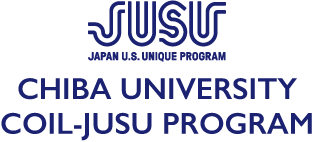History of International Society
Partner university (faculty)
College of Liberal Arts and Sciences, Chiba University and The University of Alabama
Class schedule
College of Liberal Arts and Sciences, Chiba University
Term 4-5 (Intensive)
The University of Alabama
January 8 to April 24
Time difference
15 hours
Class objectives
The study of history in a global context, and the acquisition of a diverse understanding of Japanese history and the history of US-Japan relations
Class content
International cooperative learning among three groups of students: Japanese language students at the UA, and "History of International Society" and "COIL Basic" students at Chiba University. The UA students covered the basics of Japanese history as advance study through e-learning. After acquainting with the Chiba students on Moodle, the UA students visited Japan in mid-December.
During their week-long stay in Japan, the UA students collaborated with Chiba University students in the "History of International Society" class to read over the primary sources on the history of US-Japan relations found in The Foreign Relations of the United States. They formed four groups to prepare presentations. After returning to the US, students from both universities shared files over Google Drive to complete the presentations, which took place on January 29 in a Zoom videoconference.
In addition, the "History of International Society" and "COIL Basic" classes held a joint workshop at the National Museum of Japanese History. Each group selected an era, viewed the exhibits, and created presentations on Japanese history, which were aimed at US students in general. After the UA students returned home, the presentations were uploaded to Knovio Showcase through collaborative online work in the form of online presentations, which were accessible only to the students in the class.
Class format
Synchronous and asynchronous
Tools used
Zoom, Moodle, Knovio
Visiting the design companies helped the students grasp just how much design is dependent on cultural and social systems. Thereafter, the American and Japanese students collaborated on design projects and gained perspective on issues regarding cultural differences. The presentations, rather than being mere proposals, called on students to create model products and propose concrete and usable designs. The program made the most of its students' characteristics as designers.
Presentations on the history of US-Japan relations using The Foreign Relations of the United States (January 29: Zoom meeting)
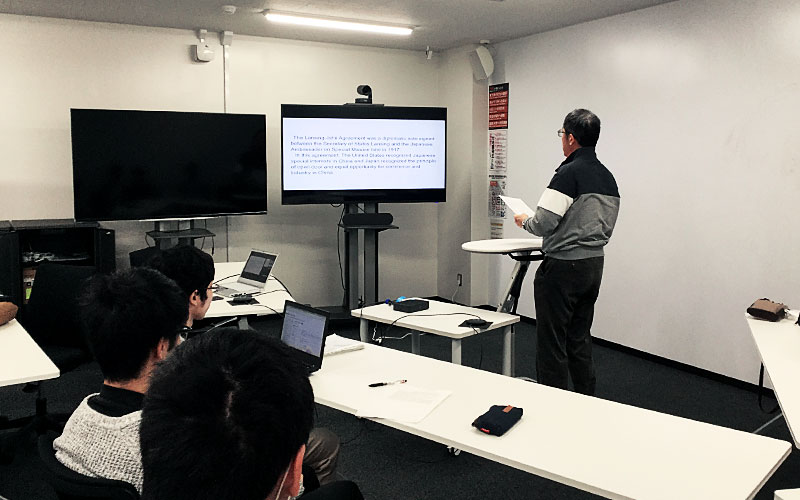 From the Chiba University side
From the Chiba University side
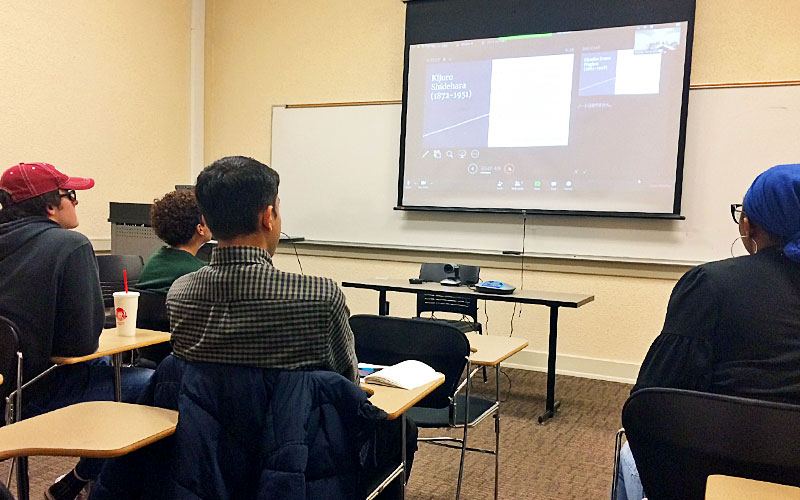
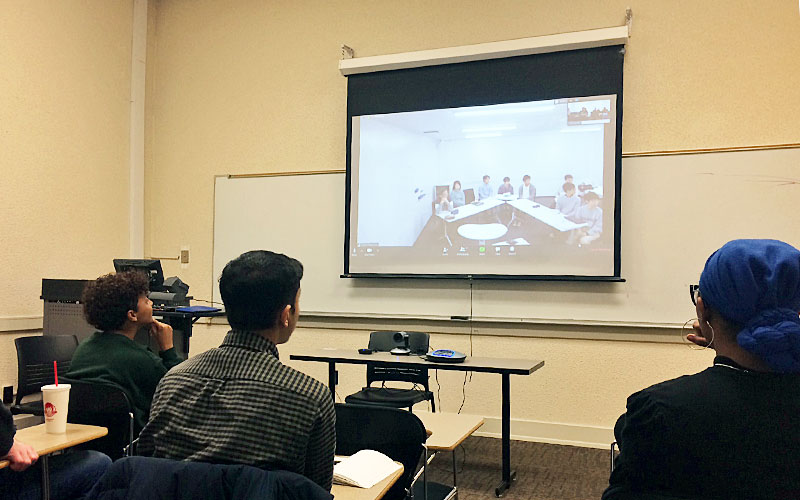 From the UA side
From the UA side
Workshop at the National Museum of Japanese History (December 19)
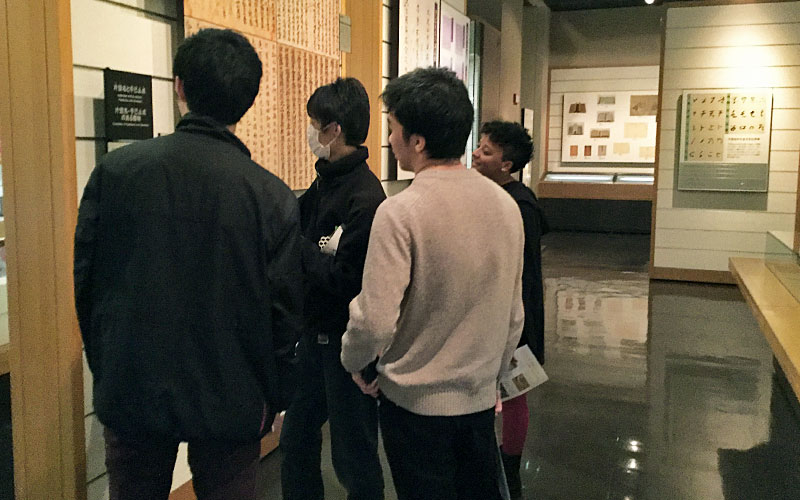
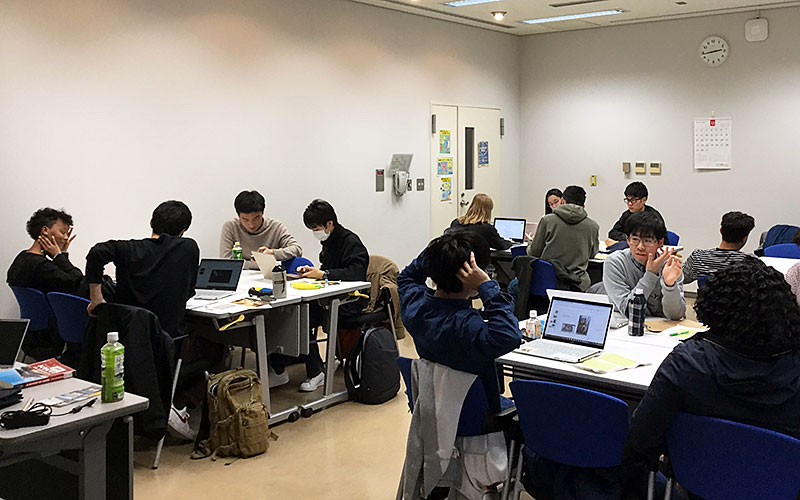
Student journal 1
College of Liberal Arts and Sciences (freshman)
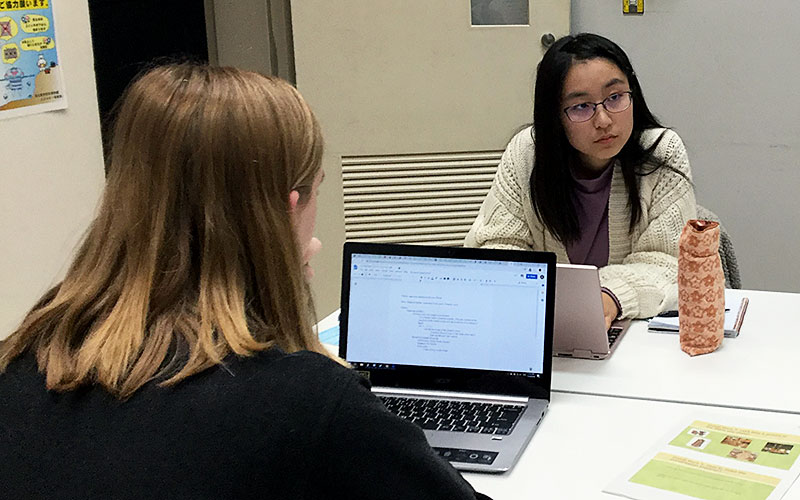 Student journal 1: Because the online Knovio page allowed us to become acquainted with the UA students' voices and styles even without meeting them in person, it was extremely useful for the interchange that followed, a real innovation. During the UA students' visit, we concentrated on strengthening our knowledge of Japanese history. After they went home, we were assigned online presentations on the coverage of the lessons. It seemed really efficient to use online collaborative study when a longer stay in Japan was impossible. The format for the assignment was to carry out our individual roles within the groups, share the results online, and finally integrate the output. We did not need to meet in person and could work comfortably in accordance with our own schedules. It was a new and interesting experience to collaborate with overseas students. If more classes use this method of collaborative study with schools overseas, then students may acquire wider perspectives and more diverse ideas. I hope this method will become more widely accepted.
Student journal 1: Because the online Knovio page allowed us to become acquainted with the UA students' voices and styles even without meeting them in person, it was extremely useful for the interchange that followed, a real innovation. During the UA students' visit, we concentrated on strengthening our knowledge of Japanese history. After they went home, we were assigned online presentations on the coverage of the lessons. It seemed really efficient to use online collaborative study when a longer stay in Japan was impossible. The format for the assignment was to carry out our individual roles within the groups, share the results online, and finally integrate the output. We did not need to meet in person and could work comfortably in accordance with our own schedules. It was a new and interesting experience to collaborate with overseas students. If more classes use this method of collaborative study with schools overseas, then students may acquire wider perspectives and more diverse ideas. I hope this method will become more widely accepted.
Student journal 2
College of Liberal Arts and Sciences (freshman)
It was a new experience to use online communication to a large extent, including introductions on Knovio (an online video platform) before the UA students came to Japan, as well as the COIL-dedicated Moodle. During the University of Alabama students' stay in Japan, we took part in active learning including a workshop at the National Museum of Japanese History, which is a Chiba University partner. When they returned to the US, we used Knovio again to complete the presentations on Japanese history and culture. The University of Alabama students in the program came from a variety of majors, from humanities to hard sciences. In this manner, perspectives based on diverse fields and beyond the lens of a single field of study were presented, as should be afforded to the liberal arts students of Chiba University, through cross-cultural communication between the US and Japan. Although this class was an intro-level course, I hope to use the experience and skills gained to participate in highly unique Japanese or American programs at a more specialized level.
実施大学(学部)
千葉大学国際教養学部 アラバマ大学
授業日程
千葉大学国際教養学部
T4-5(集中)
アラバマ大学
1/8~4/24
時差
15時間
授業目的
歴史をグローバルな文脈で学び、日本史および日米関係史の多様な理解を図る。
授業内容
アラバマ大学の日本語学習者、千葉大学「国際社会史」および「COIL Basic」受講者の三者による国際協働学習。アラバマ大生は事前学習として日本史の基礎知識をe-learningで学び、Moodle上で千葉大生と交流を深めた後に12月中旬に来日した。
1週間の日本滞在中、「国際社会史」の授業では、4グループに分かれて米国外交文書(Foreign Relations of the United States)に掲載されている日米関係史の一次史料を千葉大生と協力して読解し、プレゼンテーション作成の相談をした。帰国後、Google Driveを利用してファイルを共有しながらプレゼンテーションを完成させ、1/29にZOOMによるビデオ会議で発表した。
また、国立歴史民俗博物館において「国際社会史」・「COIL Basic」共同のワークショップを行った。各グループごとに時代を定めて展示を見学し、一般的なアメリカ人学生に対して日本史について説明するプレゼンテーションを作成した。プレゼンテーションは帰国後のオンライン上での協働作業を経て、Knovio Showcaseに掲載し、受講者限定のウェブ発表の形式をとった。
授業実施形態
同期型および非同期型
使用ツール
Zoom, Moodle, Knovio
米国外交文書を利用した日米関係史のプレゼンテーション(1月29日のZOOMミーティング)
 千葉大側から
千葉大側から

 アラバマ大側から
アラバマ大側から
国立歴史民俗博物館でのワークショップ(12月19日)


学生の体験記1
国際教養学部1年
 Knovioというオンラインのページを使用することでアラバマ大学の学生と直接会わなくても声や雰囲気がわかったため、それ以降の交流に非常に役に立ち画期的であると感じた。アラバマ大の学生の訪日では、日本史についての知識を深めることに集中し、アラバマ大生の帰国後にそれを発表するためオンライン上でプレゼンテーションを行うという課題が出された。日本への長期滞在が難しい場合でもネットを通して共同学習が行えるということが効率的だと思った。課題を行う際は、グループ内で決めた分担をそれぞれがこなし、オンライン上で共有し、最後に統合するという形式で行ったが、集まる必要性もなく、各自の予定に合わせて無理なく行えた上に、海外の学生とグループワークを行うというのが新鮮な体験で面白かった。今回のような手法を用い、海外の学校との共同学習をより多くの授業が取り入れることで、学生はより広い視野を持ち、多様な思考が可能になるかもしれない。この方法がもっと受け入れられるとよいと思った。
Knovioというオンラインのページを使用することでアラバマ大学の学生と直接会わなくても声や雰囲気がわかったため、それ以降の交流に非常に役に立ち画期的であると感じた。アラバマ大の学生の訪日では、日本史についての知識を深めることに集中し、アラバマ大生の帰国後にそれを発表するためオンライン上でプレゼンテーションを行うという課題が出された。日本への長期滞在が難しい場合でもネットを通して共同学習が行えるということが効率的だと思った。課題を行う際は、グループ内で決めた分担をそれぞれがこなし、オンライン上で共有し、最後に統合するという形式で行ったが、集まる必要性もなく、各自の予定に合わせて無理なく行えた上に、海外の学生とグループワークを行うというのが新鮮な体験で面白かった。今回のような手法を用い、海外の学校との共同学習をより多くの授業が取り入れることで、学生はより広い視野を持ち、多様な思考が可能になるかもしれない。この方法がもっと受け入れられるとよいと思った。
学生の体験記2
国際教養学部1年
アラバマ大学の学生の日本渡航前の自己紹介の時点からKnovioというオンラインビデオプラットフォームを利用したり、COIL専用のmoodleを使ったりと、オンライン上でのコミュニケーションが盛んに行われ、新鮮でした。彼らが日本に来てからは、千葉大学と提携を結んでいる国立歴史民俗博物館でのワークショップを含むアクティブラーニングを行い、帰国後には再びKnovio等を駆使し、オンライン上のみで日本の歴史文化に関するプレゼンテーションを完成させました。アラバマ大学の学生は文理問わず複数の学部からこのプログラムに参加しており、多様な分野からの視点、そして日米の異文化コミュニケーションを通じて、自分の専門にとらわれずに、より国際教養学部生らしく、ものごとを考えることができたと思います。今回の授業は入門講座であったので、今後は今回の授業で身につけた経験・スキルを活かし、より専門的で、日本もしくはアメリカの独自性の高いプログラムにも参加したいです。
